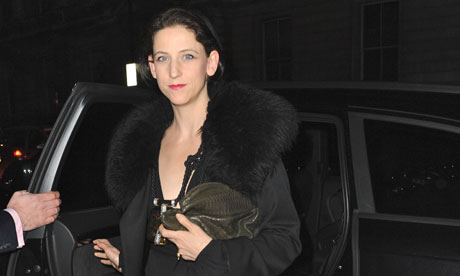
"Real", says the OED, means actually existing, genuine. It's often used to signal a contrast with something unreal, fake or conceptual. Thus real fruit content, real diamonds, real life. Where there's no doubt, we don't use it.
So why the craze for "real women"? There's Amanda Platell in the Daily Mail, proclaiming: "Even the original stick insect Victoria Beckham has jumped on the real woman bandwagon and designed her entire range around feminine curves." And then Alice Fisher and Helen Seamons in the Observer discussing Issa designer Daniella Helayel, whose clothes "are for real women who are, like herself, 'full of curves'."
We may not know what the real woman does or thinks, but we do know she's all about appearance. She' s curvy. But curvy like size 12? Size 16? No one's willing to say.
Maria Grachvogel's autumn 2011 collection is "completely wearable for real women as well as beanpoles", writes the Guardian' s Jess Cartner-Morley. Women so real that the designer gets the samples made in – gasp – size 10 rather than 8, so her team, "most of whom are roughly a size 10", can try them on.
Grachvogel's real woman, then, is different from Helayel's. It's possible for size 10 and curvy to go together – but they generally don't. For those over, say, five foot five, it would be a challenge.
For the men and the Americans, a translation. Keira Knightley is roughly a UK size 8, Carey Mulligan a 10, Kate Winslet a 12, Nigella Lawson a 14. Roughly. Sizes are determined by bust, waist and hip measurements, not height – so a 5ft size 10 and a 6ft size 10 will be quite different.
Real women aren't just about shape, though. Bidisha writes: "A man who likes a woman without pubic hair despises adult women so much that he wants us to resemble children … Upon seeing some real hair on a real woman for the first time they may well vomit or faint, or both."
So there you have it. Curvy + hairy + size 10 = real woman. Or three different real women? This is the problem with terms such as "real" , "normal" and "curvy" – they are so non-specific that they can be used to imply virtually anything. As Humpty Dumpty says: "When I use a word, it means just what I choose it to mean – neither more nor less."
There is no real woman. She is a backlash, albeit an understandable one, against the super-slim ideal of the past decade plus. She' s not like the real man. He's redolent of spanners, chest hair and sweat. He may glower, but he's kind to his mother. He's defined by what he does, not what he isn't – he's not in opposition to slightly podgy man, or hunch-shouldered man.
The real woman, however, is defined in opposition and bitterness. Her vagueness contrasts with the specificity of what she is not: beanpole, waif, stick insect, undernourished. At the extreme is Platell, howling: "No breasts, no curves, so desiccated by starvation they'd be unable to have a child even if they wanted to." Even leaving aside the implication that you're not a real woman if you can't conceive, or choose not to, this is still an insidious way to talk about thin women. (And to desiccate means to remove moisture, not food.)
The creators of the real woman purport to promote good body image, particularly for those of "average size" and above. To a certain extent, they're succeeding. But, under cover of deliberately vague language, they're also creating a new pariah: "unreal woman". There's no place in journalism for linguistic cowardice, even less so when it's born of casual bigotry. Writing should be done with honesty and clarity – especially when the subject is as delicate as body image.
Can't do that? Get real.
Cathy Relf blogs at www.rantingsubs.com

